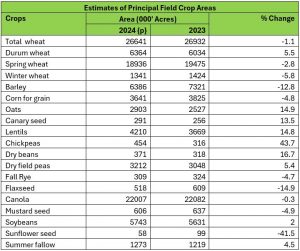Canadian farmers reported planting more Lentils, Dry Peas, Soybeans, and Oats, but fewer acres of Wheat, Canola, Corn and Barley, according to the June 2024 Field Crop Survey.
Provincial reports indicated slower seeding progress compared with the five-year average, but most areas had been planted by the first week of June. In general, average temperatures across the Prairies were mixed, with some cooler areas receiving snowfall and near-freezing conditions during planting. In Eastern Canada, temperatures were at or above normal early in the 2024 growing season. Despite warm conditions, above-normal precipitation in Ontario resulted in some seeding delays, while most of Quebec and Atlantic Canada were drier than normal.
Wheat: At the national level, farmers reported seeding fewer acres of wheat in 2024, down 1.1% to 26.6 million acres. Although this is down compared with the previous year, wheat area remained well above the five-year average of 25.0 million acres, possibly because of favorable pricing. Lower total wheat area was driven by spring wheat (-2.8% to 18.9 million acres) and winter wheat (-5.8% to 1.3 million acres), offsetting higher durum wheat area (+5.5% to 6.4 million acres). Producers in Saskatchewan reported planting 14.2 million acres of wheat in 2024, unchanged from the previous year. Spring wheat area fell 2.1% to 9.0 million acres but was offset by durum wheat, which rose 2.9% to 5.1 million acres. In Alberta, wheat area was down 1.6% to 7.8 million acres in 2024. The decrease was driven by spring wheat area, which decreased 4.9% to 6.5 million acres, while durum wheat area rose 19.4% to 1.2 million acres. Manitoba producers reported that total wheat seeded area decreased 1.4% to 3.2 million acres in 2024.
Corn for grain: Farmers reported seeding less corn for grain in 2024, falling 4.8% from the previous year to 3.6 million acres. In Ontario, where roughly 60% of all corn for grain is grown, farmers reported a 4.6% decrease in seeded area to 2.2 million acres in 2024. Similarly, corn for grain area in Quebec dropped 2.1% to 879,000 acres compared with 2023, while the area in Manitoba decreased 10.7% to 494,600 acres.
Lentil Area: In 2024, Canadian farmers reported planting 4.2 million acres of Lentils, up 14.8% from one year earlier and above the five-year average area. Both major lentil-producing provinces reported higher seeded area, with that in Saskatchewan increasing 14.0% to 3.6 million acres, while that in Alberta rose 19.6% to 559,700 acres.
Dry Peas: Farmers reported seeding 5.4% more area with dry peas compared with 2023, rising to 3.2 million acres in 2024. Dry pea area in Saskatchewan increased 8.7% to 1.7 million acres, while Alberta’s area fell 1.4% to 1.2 million acres.
Canola: Farmers reported planting 22.0 million acres of canola in 2024, down 0.3% from the previous year. In Saskatchewan, where more than half of Canada’s canola is grown, farmers reported planting 12.1 million acres of canola in 2024, down 2.5% from 2023. In Alberta, farmers reported planting 6.4 million acres of canola in 2024, up 0.4% from the previous year, while in Manitoba, farmers reported seeding 3.3 million acres, up 6.6% from 2023.
Soybeans: Soybean area rose 2.0% to 5.7 million acres in 2024. This is above the five-year average and the highest area since 2018. Producers in larger soybean-growing provinces may have opted to seed soybeans based on good prices relative to other crops, such as corn. In Ontario, where the majority of the country’s soybeans are grown, farmers reported planting 3.1 million acres of soybeans in 2024, up 7.1% from one year earlier. For the second consecutive year, farmers in Quebec reported seeding a record soybean area. Soybean area rose to 1.1 million acres in 2024, up 6.8% from 2023.

(Source: Statcan)